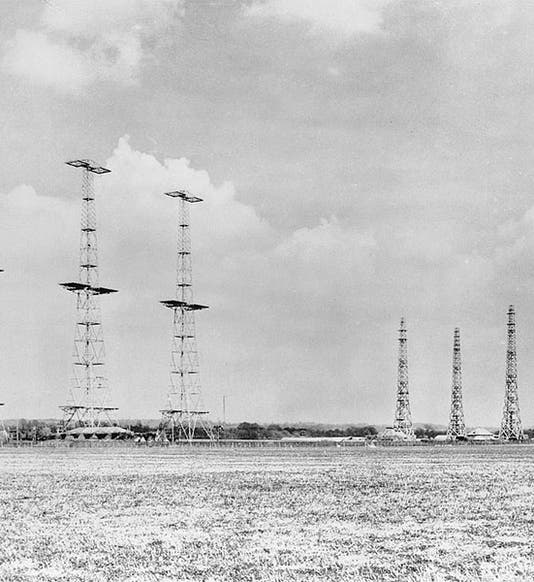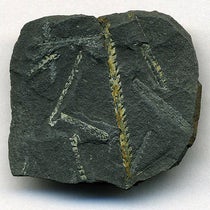Scientist of the Day - Robert Watson-Watt
Robert Alexander Watson-Watt, a Scottish engineer, died Dec. 5, 1973, at the age of 81. Watson-Watt was a pioneer in using radio for purposes other than communication. During World War I, he worked in the Meteorological Office, where he discovered how to use radio antennas to detect thunderstorms. After the War, he worked at the National Physical Laboratory at Slough in Berkshire, and when the Radio Research Station was formed in 1927, he became its director, and his team learned how to bounce radio waves off the ionosphere (which Watson-Watt named) and, by measuring the travel time of the waves, to determine its changing height.
With the rise of Hitler in 1933 and his boasting about invading England, there was concern among British military officials about air defense. The Royal Navy was powerful enough, it was thought, to thwart any attempt to invade by sea, but the skies were a problem. German bombers could reach English targets in just 30 minutes from European airfields, and fighters could not be scrambled in time once the bombers showed up on the horizon. Fortunately, some high officials saw this as an immediate, life-or-death problem as early as 1934. One of these was Henry Tizard, a chemist who has served in the Royal Flying Corps, and who was very worried about the lack of any system of aerial defense in England. He understood that the key element of such a system would be learning exactly where the enemy was and what direction they were headed, before they got to England, so that defensive aircraft could be deployed and waiting in the skies for the attack. Tizard convinced others of the urgency of the situation, and in December 1934, he became chair of a committee to study English air defense and prepare England for aerial attack (another member of that committee was Patrick Blackett, whom we profiled just last month).
One of the questions that arose in their first meetings in January of 1935 was whether it was possible to use a powerful ray to shoot down enemy planes. So the committee reached out to Watson-Watt, the country's radio-wave expert. Watson-Watt responded that death rays were a science-fiction fantasy, but that it might be possible to use radio waves as detectors, by bouncing them off the metal hull of an airplane, and detecting the return signal. This was not the first proposal of radar, but it was the first time anyone with authority was listening. Watson-Watt and his right-hand man, Arnold Wilkins, calculated that the return signal would be only about one-tenth of one-quintillionth (10-19) of the signal sent out, but if one could increase transmitter power, receiver detection levels, and antenna gain, it might be possible to make radar workable. He responded to the Tizard committee, as it came to be called, on Feb. 12, 1935, and Tizard was immediately interested, and asked for a demonstration.
On Feb. 26, 1935, a bomber was instructed to fly by a new BBC transmitter in Daventry. Watson-Watt and Wilkins were in a van nearby, with an array of radio receivers, and they successfully picked up reflected radio waves as a blip on their oscilloscope when the plane passed by. The Daventry experiment, as it is now called, was a success, and that was good enough for Tizard; he put Watson-Watt in charge of developing a radar defense system and provided him with ample funds to do the job right. The receivers used by Watson-Watt that day are on display in the Science Museum, London (third and fourth images).
Watson-Watt immediately began hiring engineers, the first addition being Edward George “Taffy” Bowen, who would later develop airborne radar. The team built more powerful transmitters, and discovered that pulsing the transmission not only provided more power, but allowed them to determine the distance to an aircraft, as well as its direction. In those days the only transmitters in use were in the 10-100-meter range, which meant large transmission antennas were necessary. A series of massive 360-foot steel towers were erected along England's and Scotland’s eastern coast, all the way from Southampton to the Shetland Islands (see map, fifth image). The height of these towers meant the pulses could be sent out horizontally, giving them a range of nearly 100 miles. The receiving towers were less lofty, but still impressive in size, and they were offset in a rhombus of four towers, so that the direction of the return pulse could be more accurately determined by phase differences. This array of antennas, transmitters and receivers was code-named the Chain Home system, and it was fully in place and operational when the Battle of Britain began in 1940. The Germans were amazed that before their bombers even arrived at their targets, British fighters were in place to oppose them, and the German high command concluded that the British had far more planes than they really did, which led them eventually to call off the siege, leaving England with its first war victory. Credit for the success has been awarded to Watson-Watt's Chain Home installation, and to the Dowding System, a network that fed all the radar and spotting information into a central headquarters, so that data gathered could be rapidly disseminated to the fighter squadrons, making sure that the radar information provided by Chain Home did not go to waste.
Taffy Bowen later wrote a popular book about his role in the development of airborne radar during the war (Radar Days, 1987), which I had not read when I wrote my post on Bowen (shame on me). So I read the first part of the book while researching this piece, and I was surprised that Bowen wrote about Watson-Watt in glowing terms, which is not always the case when an underling writes about his first boss, especially when that individual was then deceased. The American physicist and Nobelist, Luis Alvarez, in his autobiography (Adventures of a Physicist, 1987), also spent some pages discussing his war-time involvement with the British, and he too was full of praise for what Watson-Watt accomplished. So this appears to be one of those rare instances where an administrator really deserved the applause and was not merely stealing credit from his working team.
I have often wondered what would happen in these times if a Watson-Watt wrote a high government official and said, here is what we should do to forestall disaster. Would he or she receive approval and funding by return mail? Would there be any answer at all?
William B. Ashworth, Jr., Consultant for the History of Science, Linda Hall Library and Associate Professor emeritus, Department of History, University of Missouri-Kansas City. Comments or corrections are welcome; please direct to ashworthw@umkc.edu.











